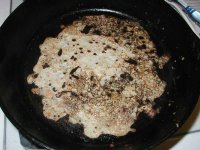
It is called Adai or Dal Dosa, an Indian pancake. Last Sunday, I decided to try another type of dosa which is made of Lentil, Bean, and Grain: White Gram Lentil(Urad Dal), Yellow Split Pea (Chana Dal), and Jasmine Brown Basmati rice. It is not as thin as crepe but not as thick as American pancake, more like a Korean pancake, so I call it a pancake.
Throughout my Indian cooking this week, I realized that I am using the combination of lentils, beans, and grain all the time. I think it is a smart way of cooking vegetarian dishes, since you know, I got this question all the time from non-vegetarian friends: ‘Where do you get your protein?’ I learned something from the South Indians, they know where to get their protein. Maybe because vegetarianism has been a way of life for thousands of years in India so they know how to include protein in almost every dish.
I had to soak the lentil, bean, and grain in water and then ground them into a coarse batter. I also added some Indian spices, chilies, and lots of chopped cilantro into it. The dough was much thicker than American pancake batter, more like a muffin batter, so I had to spread it round with a spatula on a hot cast iron skillet. The Indian way is to use your hand but I was not going to sacrifice my pretty fingers to the hot skillet, knowing that I am a novice. According to the recipe, I need to make a 1/2–inch hole in the middle of it. ‘What’s the hole for?’ my husband asked since he has never eaten a pancake with a hole in the middle of it. It is to put 1 teaspoon of oil in the middle of the hole so the oil can spread to the sides of the pancake and the bottom while it’s cooking, to make it crispy. I made it like that for my husband but I opted not to add the oil for mine.
According to the recipe, this pancake is scrumptious to be eaten with butter (we use Earth Balance, of course) and powdered jaggery (a natural Indian vegan sugar) on top. My friend, Val, gave me jaggery a few weeks ago in the form of cubes that I crushed into powder. I chose not to add Earth Balance too, to be in a lower fat diet. My husband did eat it with both and it was indeed scrumptious!
The picture above displayed the pancake served with Earth Balance on top and Tomato Rasam (soup) and powdered jaggery on the side. Both recipes were taken from Chandra Padmanabhan's Dakshin: Vegetarian Cuisine from South India .
Nutrition Facts (without the oil and Earth Balance):
Nutrition (per serving): 148.5 calories; 11% calories from fat; 2.1g total fat; 0.0mg cholesterol; 200.8mg sodium; 197.0mg potassium; 26.9g carbohydrates; 3.6g fiber; 2.4g sugar; 23.3g net carbs; 6.1g protein; 2.4 points.




